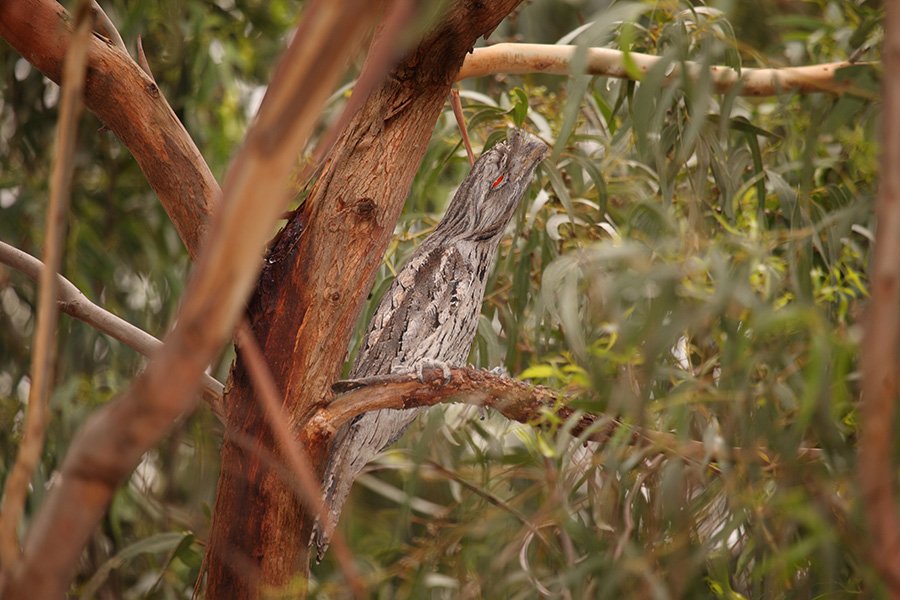Tawny frogmouths: 5 things you may not know about these masters of disguise

Masters of disguise, with the deadliest of stares, the tawny frogmouth (Podargus strigoides) is one of Australia’s most beloved birds. But because they’re most active at night, their unique behaviours are less obvious to us.
According to Australia’s pre-eminent tawny frogmouth expert Gisela Kaplan, who has recently compiled 20 years of observations into a new book on this unique nocturnal bird, these birds live complex lives we still know very little about.
So to help you foster a better understanding of the tawny frogmouth, here are a few things you might not have known about them.
They spray predators with their faeces
Of course, tawny frogmouths are known for their very effective camouflage, but if a predator persists, it can get messy.
The frogmouths’ first response is to mob, using their beaks to peck at nest intruders. If this fails, the tawny will then spray the predator with their faeces.
According to Gisela, this confuses the predator, especially snakes, monitors and other animals that rely on their sense of smell. And it can take weeks for the smell to go away.
They mate for life
Promiscuity for the sake of increasing breeding success just isn’t for frogmouths. Instead, they tend to choose a partner for life.
The male tawny frogmouth is fiercely territorial and protective of their nests, and will often drive off any male who tries to intrude.
These frogmouth pairs are so close that they evict their offspring and spend the rest of their lives close together, perching on trees, leaning against and grooming each other.
So how do they find the perfect mate? There’s no evidence of courtship between these birds, but it has been suggested that vocal signals and pupil dilation may play a part.
They’re well-adapted to Australia’s unpredictable weather
Tawny frogmouths are so well-insulated by their feathers that neither the cold, nor the heat has much of an effect on them.
Based on Gisela’s observations, the tawny won’t show notable signs of heat distress even as the temperature soars to more than 30 degrees.
Rather than opening their beak for better ventilation, the tawny can triple their breathing rate with their beaks closed and produce a type of mucus in their mouths that helps to cool the air as they inhale, which then cools their body.
When the weather is colder, the tawny is one of the only large birds that go through small bouts of torpor — a type of winter hibernation — to cope with the loss of heat and energy.
They’ve been known to “cry”
The tawny uses a number of different calls to express everything from fear to annoyance. However, the most saddening is what Gisela has termed the “whimpering call”.
Describing it as “gut-wrenching” and similar to the “low whimper of a newly born baby in serious pain” this particular call can go on for an entire night.

Gisela once observed a bird making this call for several days after a female tawny had lost her male partner in a road accident. The bird then rejected partners for the following two years, which Gisela says may indicate an emotion of grieving.
The whimpering call has also been observed in birds that are about to leave the nest and birds that have been newly orphaned.
They’re terrible at building strong nests
Master nest builders, tawny frogmouths are not. The male tawny will often pick up a few sticks and some leaves and dump them into place; no arrangement and nothing to secure anything in place.
Gisela says that, with the exception of pigeons, these frogmouths are the least accomplished of Australia’s nest-building birds.
In some cases, tawny frogmouths will just hijack the abandoned nests of different birds.
Some research has suggested that because tawny frogmouth nests aren’t secure, chicks will often fall, or the parent will accidentally kick an egg out of the tree while trying to get comfy.
It’s possible that this lack of skill when it comes to nest-building is because tawny frogmouths have relied on the sturdy, large branches of flaky-barked eucalypt trees, few of which exist in large numbers today.

